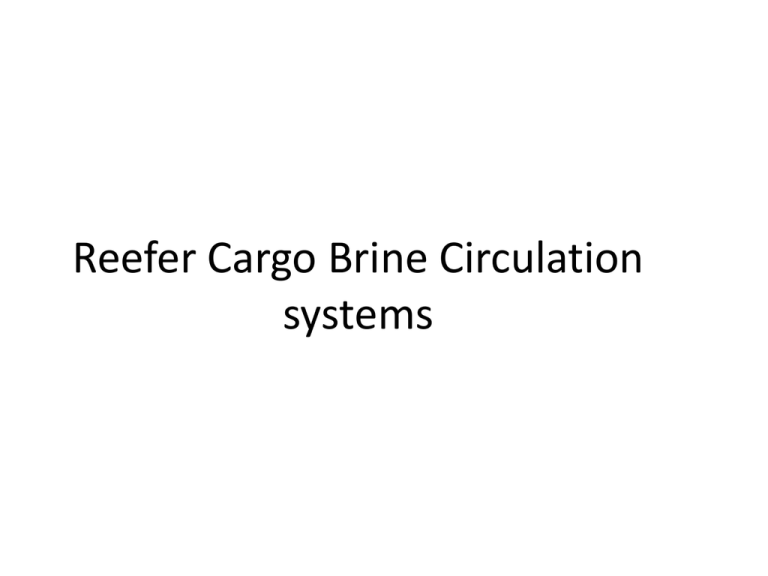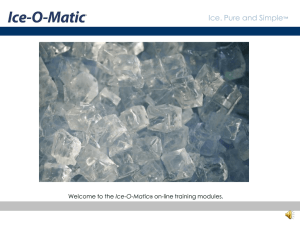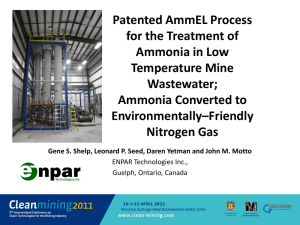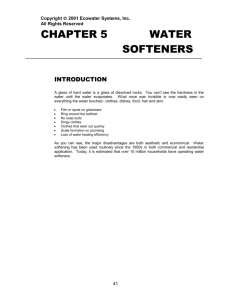Reefer Cargo Brine Circulation System
advertisement

Reefer Cargo Brine Circulation systems Carriage of refrigerated cargo • Refrigerated cargo can be carried in 1. Specialised “Reefer Ships” 2. Refrigerated containers. Reefer Ships • Reefer ships are effectively large refrigerators, heavily insulated with modern glass fibre or similarly efficient insulation , shuttered with bright metal that prevents taint and is easy to clean. They are ships that tend to be divided into many more spaces than conventional dry cargo ships, with several ’tweendecks spaces, so that different commodities can be separated and carried, if required, at different temperatures. Cleanliness and the maintenance of optimum temperatures are the pre-requisites. • The main features of a modern, 450,000 ft3 reefer vessel are as follows. • Four holds with 4 or 5 cargo decks, each with the same clear head of 2.2m to minimize lost load space when storing standard pallets (1.2m long x 1.0 m wide x 2.1 m high maximum). These decks are arranged usually in eight air tight temperature zones, with the air coolers placed along the bulk-heads serving one or sometimes two decks. Variable speed fans are placed above the coolers forcing air through, under the grating then vertically from bottom to top through the cargo and back to the coolers. • Four fast cranes able to handle a 40 ft container laden, for example, with frozen meat. • Space for eighty or more integral containers on the weather deck, and space for fork lift trucks and pallet cages. Air circulation and refreshing • Between 90 and 120 air changes of the net volume per hour is usually provided in holds. Such volume flow guarantees good and uniform cooling rate of palletized and bulk cargo and allows for imperfect storage. This air rate will be reduced on completion of cooling down and when frozen cargo is carried. • Air refreshing rates to remove carbon dioxide, ethylene and other volatiles, can be two or three air changes per hour. Brine battery and air • In this system, brine instead of primary refrigerant is circulated through the batteries. Air is cooled in a brine cooling system and cold air ducted to the cargo spaces. • Brine is relatively easy to regulate. The system shown is arranged with three separate refrigeration and brine circuits with connections from both brine systems to the air cooler batteries (or grids). Brine is inexpensive, being made with calcium chloride and fresh water to a gravity of about 1.25. Sodium dichromate or lime may be added to maintain the brine in an alkaline condition. Calcium Chloride Brine CALCIUM CHLORIDE / BRINE Specific Gravity Hydrometer Reading Freezing Point of Solution (Twaddell) °C °F 1·20 40 -21 -6 1·21 42 -23 -9 5 1·22 44 -25 -13 1·23 46 -27 -17 1·24 48 -30 -21.5 1·25 50 -32 -26 1·26 52 -35 -31 1·27 54 -38 -37 1·28 50 -42 -44 1·29 58 -51 -60 Single Space Single Evaporator Expansion tank Freon/Ammonia inlet Freon/Ammonia outlet Evaporator Cold Air to space Battery pump Five Spaces Single Evaporator Expansion tank Freon/Ammonia inlet Evaporator Return Header pump Delivery/supply Header Five Spaces Double Evaporator Expansion tank Freon/Ammonia inlet Evaporator Return Header Evaporator pump Delivery/ supply Header Five Spaces Double Evaporator 1 brine Freon/Ammonia inlet heater, 1 injection Expansion tank Evaporator Return Header Evaporator Bypass valve Brine heater pumps Delivery/ supply Header Showing third pair of headers served by a brine heater and third pump, so that any battery can be individually defrosted by circulating the warm brine. Also introduced is a brine "injection cross connection from the delivery of pump No. 1 to the suction of' pump No. 2. Brine injection is used so that evaporator No. 1 can assist evaporator No. 2 when No. 1 is set to deliver brine at a lower temperature than No. 2. A further refinement of this injection is the by-pass arranged across the inlet and outlet of evaporator No. 2 so that the cooling, of the brine circulating in No. 2 system can be achieved entirely by injection if desired.











